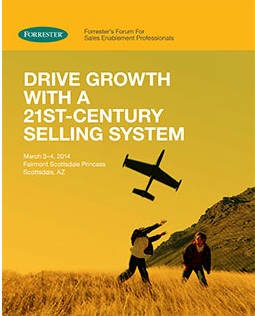How Top Marketers Use Customer-Centered Content To Make Their Message More Valuable
Quiz time folks: What is "90%"?
(No, it's not the percentage of professional football fans who could care less that the Seahawks trounced the Broncos at the Super Bowl … although I would be counted in that number.)
It is the amount of marketing-produced content that sales DOESN'T use in selling, according to the AMA (and other sources).
This certainly doesn't mean most marketing is useless, but it's a telling statistic about the divide that separates marketing messages that operate at 30,000 feet from sales conversations that happen at 3 feet — the average distance between a salesperson and a prospect during a sit-down meeting.
In this digital age, it's increasingly important for marketing to play a bigger role in helping sales not just get "your" message in front of a customer, but to make it "their" message — something that the buyer cares enough about to talk to your rep and to do something that upsets the status quo as a result. It's about creating content that can play dual roles: attracting and educating buyers while giving sales a deeper understanding about what's attracting that attention in the first place. To achieve both, marketers have to understand their buyers. Better. Deeply. Obsessively.
Armed with knowledge, marketing can change its content focus from product facts and feature benefits to sharing interesting insights on solving key business problems. Buyers like insight and pay attention to it earlier in the purchase process. Sales can also use this insight to focus their conversations around the issues decision-makers face and teach them something new. It helps sales tailor the solution around what the buyer really needs, not what they have to offer (which, when done properly, ends up being the same thing.) When marketing can help sales get into the purchase process early, our research shows win rates go up.
Easier said than done, right?
 Of course, but there are marketers who are making this transition successfully and two of them will be at Forrester's Forum For Sales Enablement Professionals, March 3-4 in Scottsdale, Arizona. I hope you'll join me there as I talk with Lindsay Allen, Vice President of Marketing for Superior Essex Communications and Steve Mann, Chief Marketing Officer for Research & Litigation Services at LexisNexis. Both will share the practicalities of what it takes to develop deep knowledge about customer issues and to use this insight to develop content that communicates business value, not just information about the "4 P's".
Of course, but there are marketers who are making this transition successfully and two of them will be at Forrester's Forum For Sales Enablement Professionals, March 3-4 in Scottsdale, Arizona. I hope you'll join me there as I talk with Lindsay Allen, Vice President of Marketing for Superior Essex Communications and Steve Mann, Chief Marketing Officer for Research & Litigation Services at LexisNexis. Both will share the practicalities of what it takes to develop deep knowledge about customer issues and to use this insight to develop content that communicates business value, not just information about the "4 P's".
At LexisNexis, Steve conducted interesting ethnographic studies that showed surprising trends in how millennial attorneys think differently about their careers and have different expectations about taking the traditional law firm journey. These insights are helping LexisNexis change its product delivery model and develop new tools that help younger attorneys network and stay connected (not only to each other, but to LexisNexis content, making them more likely to become lifetime customers).
In a business commoditizing quickly, and selling wire, cable and accessories primarily through distributors, Superior Essex needed to stand out. Lindsay will share how he hired Corporate Visions (disclosure: a sponsor of our event) to create customer-focused materials, using more-modular presentations and incorporating blogs and social media, to help increase distribution channel productivity by 40%.
Ultimately, these are stories about how customer-focused marketing content, when designed to serve the right role in the right part of the buyer's journey, helps deliver more powerful business results. And how to make those high-flying marketing messages hit home when they come out of the salesperson's mouth. Take a look at the whole Scottsdale agenda; it's full of more ways that will help you make your marketing messages matter.
